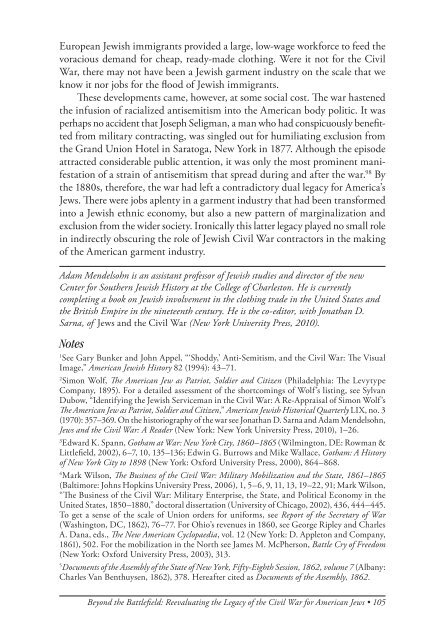American Jewish Archives Journal, Volume 64, Numbers 1 & 2
American Jewish Archives Journal, Volume 64, Numbers 1 & 2
American Jewish Archives Journal, Volume 64, Numbers 1 & 2
You also want an ePaper? Increase the reach of your titles
YUMPU automatically turns print PDFs into web optimized ePapers that Google loves.
European <strong>Jewish</strong> immigrants provided a large, low-wage workforce to feed the<br />
voracious demand for cheap, ready-made clothing. Were it not for the Civil<br />
War, there may not have been a <strong>Jewish</strong> garment industry on the scale that we<br />
know it nor jobs for the flood of <strong>Jewish</strong> immigrants.<br />
These developments came, however, at some social cost. The war hastened<br />
the infusion of racialized antisemitism into the <strong>American</strong> body politic. It was<br />
perhaps no accident that Joseph Seligman, a man who had conspicuously benefitted<br />
from military contracting, was singled out for humiliating exclusion from<br />
the Grand Union Hotel in Saratoga, New York in 1877. Although the episode<br />
attracted considerable public attention, it was only the most prominent manifestation<br />
of a strain of antisemitism that spread during and after the war. 98 By<br />
the 1880s, therefore, the war had left a contradictory dual legacy for America’s<br />
Jews. There were jobs aplenty in a garment industry that had been transformed<br />
into a <strong>Jewish</strong> ethnic economy, but also a new pattern of marginalization and<br />
exclusion from the wider society. Ironically this latter legacy played no small role<br />
in indirectly obscuring the role of <strong>Jewish</strong> Civil War contractors in the making<br />
of the <strong>American</strong> garment industry.<br />
Adam Mendelsohn is an assistant professor of <strong>Jewish</strong> studies and director of the new<br />
Center for Southern <strong>Jewish</strong> History at the College of Charleston. He is currently<br />
completing a book on <strong>Jewish</strong> involvement in the clothing trade in the United States and<br />
the British Empire in the nineteenth century. He is the co-editor, with Jonathan D.<br />
Sarna, of Jews and the Civil War (New York University Press, 2010).<br />
Notes<br />
1 See Gary Bunker and John Appel, “‘Shoddy,’ Anti-Semitism, and the Civil War: The Visual<br />
Image,” <strong>American</strong> <strong>Jewish</strong> History 82 (1994): 43–71.<br />
2 Simon Wolf, The <strong>American</strong> Jew as Patriot, Soldier and Citizen (Philadelphia: The Levytype<br />
Company, 1895). For a detailed assessment of the shortcomings of Wolf’s listing, see Sylvan<br />
Dubow, “Identifying the <strong>Jewish</strong> Serviceman in the Civil War: A Re-Appraisal of Simon Wolf’s<br />
The <strong>American</strong> Jew as Patriot, Soldier and Citizen,” <strong>American</strong> <strong>Jewish</strong> Historical Quarterly LIX, no. 3<br />
(1970): 357–369. On the historiography of the war see Jonathan D. Sarna and Adam Mendelsohn,<br />
Jews and the Civil War: A Reader (New York: New York University Press, 2010), 1–26.<br />
3 Edward K. Spann, Gotham at War: New York City, 1860–1865 (Wilmington, DE: Rowman &<br />
Littlefield, 2002), 6–7, 10, 135–136; Edwin G. Burrows and Mike Wallace, Gotham: A History<br />
of New York City to 1898 (New York: Oxford University Press, 2000), 8<strong>64</strong>–868.<br />
4 Mark Wilson, The Business of the Civil War: Military Mobilization and the State, 1861–1865<br />
(Baltimore: Johns Hopkins University Press, 2006), 1, 5–6, 9, 11, 13, 19–22, 91; Mark Wilson,<br />
“The Business of the Civil War: Military Enterprise, the State, and Political Economy in the<br />
United States, 1850–1880,” doctoral dissertation (University of Chicago, 2002), 436, 444–445.<br />
To get a sense of the scale of Union orders for uniforms, see Report of the Secretary of War<br />
(Washington, DC, 1862), 76–77. For Ohio’s revenues in 1860, see George Ripley and Charles<br />
A. Dana, eds., The New <strong>American</strong> Cyclopaedia, vol. 12 (New York: D. Appleton and Company,<br />
1861), 502. For the mobilization in the North see James M. McPherson, Battle Cry of Freedom<br />
(New York: Oxford University Press, 2003), 313.<br />
5 Documents of the Assembly of the State of New York, Fifty-Eighth Session, 1862, volume 7 (Albany:<br />
Charles Van Benthuysen, 1862), 378. Hereafter cited as Documents of the Assembly, 1862.<br />
Beyond the Battlefield: Reevaluating the Legacy of the Civil War for <strong>American</strong> Jews • 105
















